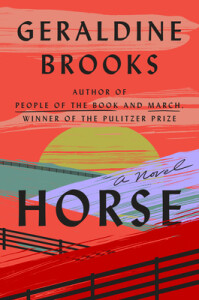
This novel succeeds on so many levels. Brooks weaves together multiple storylines, with different narrators and time periods, ensuring that the story reveals itself smoothly.
We start in 2019 in Washington, D.C. A graduate student from Nigeria is working on a magazine article related to his studies in art history when he notices his elderly neighbor, the one who has always been rude to him, lugging heavy items—probably her late husband’s things—out to the curb. Theo goes out to help. She refuses but tells him to take what he wants. Politely he pulls out a dirty oil painting of a horse.
At the same time, in a Maryland suburb of D.C., Jess works for the Smithsonian running a lab where she and her team clean animal bones and sometimes wire them back together. Originally from Australia, she begins working with a scientist from England studying the skeleton of what was once the most famous horse in the U.S., a skeleton that has gotten lost in the Smithsonian’s storage units.
The we move to Kentucky in 1850 where we meet Jarret, a slave who has grown up with horses and has an amazing affinity with them. His father Harry, who has bought his own freedom and is saving up to buy Jarret’s, is the head trainer for the plantation owner’s racehorses. Jarret and Harry are with the mare when she gives birth in the night.
These are the main threads, but we also get the stories of the itinerant horse painter Thomas J. Scott who later volunteers with the Union army, a rebellious daughter of Jarret’s original owner, and the New York gallery owner Martha Jackson in the mid-1950s who specialises in modernist artists but finds a 19th century painting of a horse irresistible.
So, yes, this is a story about a horse, beautifully written, with leisurely scenes full of luscious period details. It is also the story of the United States, from the antebellum world to the present. Inevitably it is about what Wendell Berry called the U.S.’s hidden wound. Yet race is mentioned only as it is integral to the story, whether it’s an abolitionist dressing down his in-laws at dinner, the Talk that both the Australian and the Nigerian missed, or the chapter headings that identify the boy as Warfield’s Jarret, then Ten Boeck’s Jarret, and so on through the book.
For me, the story moves beyond race into thinking about those who want to achieve great things, whether it is a horse eager to run, a child who wants to be free to exercise his particular skill with horses, or an athlete such as a gymnast or tennis player, ballet dancers—the list goes on—and those who profit from them. There is much in the news about the dangers of playing football, the emotional and physical damage of pushing young athletes too hard, and the potential for abuse of young people who want to win. Yet they DO want to win.
The novel is also about science and art and where they intersect. Brooks stirs in us that peculiar pleasure that comes from hard, creative, purposeful work. Woven into the story, too, are the opportunities denied to the women of the 1850s and 1950s.
Brooks’s novel enthralled me, chores postponed as I plunged into each new chapter, savoring the texture of each scene, and moving easily between the different worlds.
Looking back, I’m surprised by the last item. I am generally not a fan of novels with multiple point-of-view characters, yet here the transitions are so smooth that I barely noticed. It felt as though we were all sitting around a campfire passing around a talking stick, taking turns to tell what is so clearly one story.
I particularly dislike the kind of omniscience that moves from one character’s thoughts to another’s in the same scene. Brooks rarely does this, but it’s smooth as butter when she does.
I’ve been studying one scene in particular between Harry and Jarret when they receive bad news. We start with Jarret’s thoughts, move into Harry’s, and then back into Jarret’s within the space of two pages. It works because there’s plenty of dialogue to anchor the scene, and the moments of transition are moments of high emotion so the shift feels right. Also, Brooks also uses action as a bridge in those two transitional moments.
Whether you are interested in horses or not, you’ll find much to enjoy in this novel. It is the story of us, what we strive for, and the price involved. There’s much to think about here.
Have you read a Geraldine Brooks novel that you enjoyed? What did you like best about it?